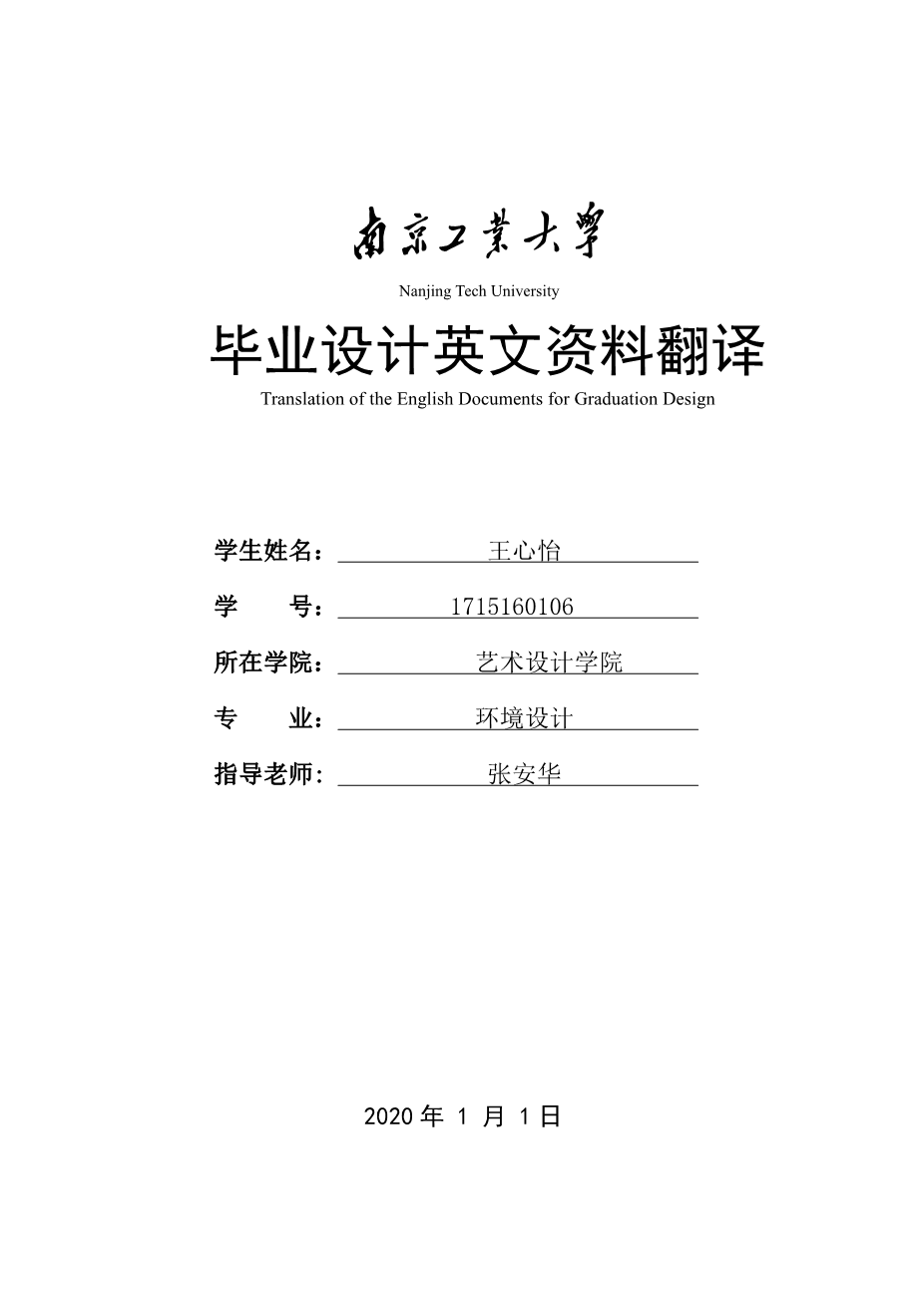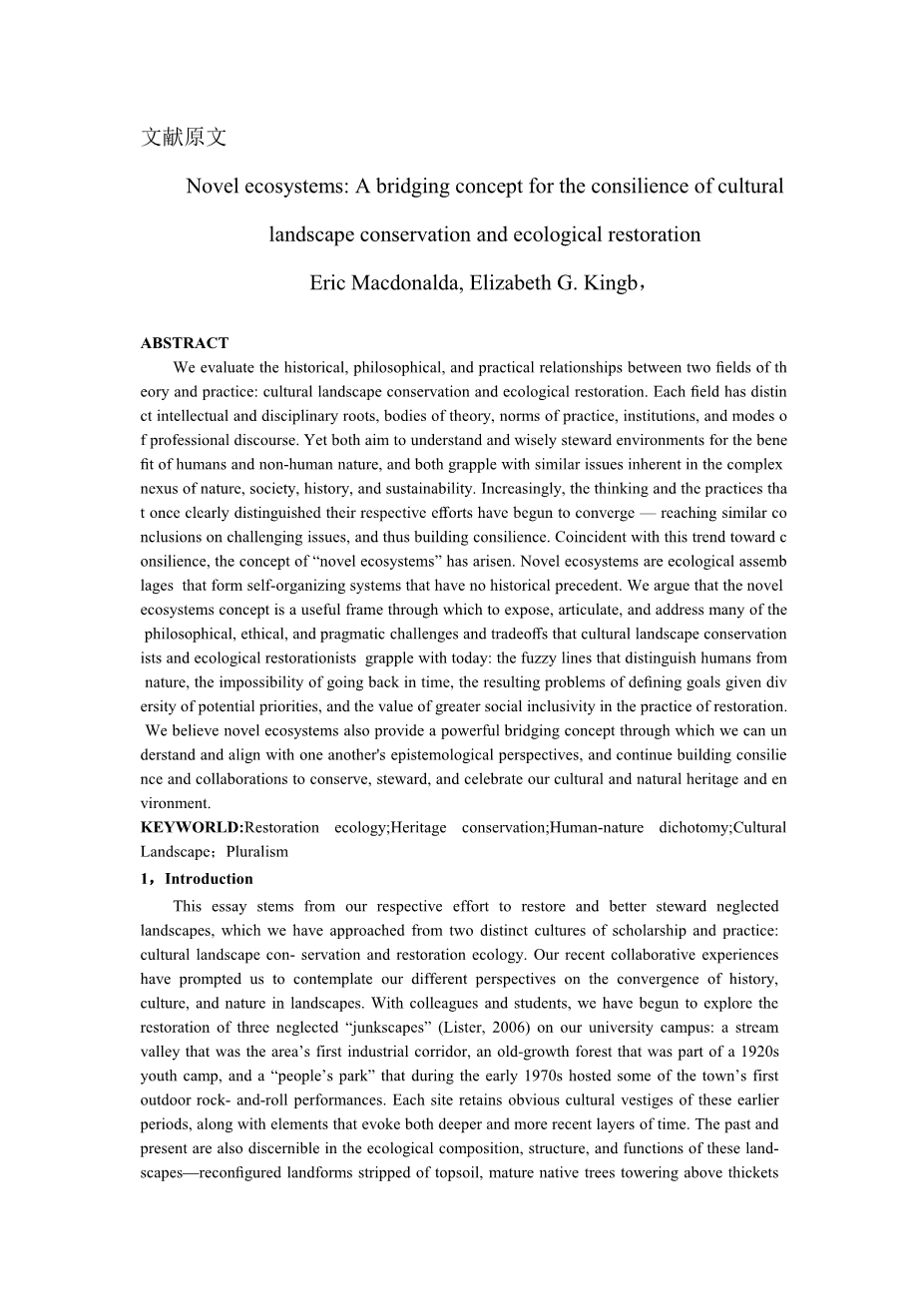Nanjing Tech University
毕业设计英文资料翻译
Translation of the English Documents for Graduation Design
文献原文
Novel ecosystems: A bridging concept for the consilience of cultural
landscape conservation and ecological restoration
Eric Macdonalda, Elizabeth G. Kingb,
ABSTRACT
We evaluate the historical, philosophical, and practical relationships between two fields of theory and practice: cultural landscape conservation and ecological restoration. Each field has distinct intellectual and disciplinary roots, bodies of theory, norms of practice, institutions, and modes of professional discourse. Yet both aim to understand and wisely steward environments for the benefit of humans and non-human nature, and both grapple with similar issues inherent in the complex nexus of nature, society, history, and sustainability. Increasingly, the thinking and the practices that once clearly distinguished their respective efforts have begun to converge — reaching similar conclusions on challenging issues, and thus building consilience. Coincident with this trend toward consilience, the concept of “novel ecosystems” has arisen. Novel ecosystems are ecological assemblages that form self-organizing systems that have no historical precedent. We argue that the novel ecosystems concept is a useful frame through which to expose, articulate, and address many of the philosophical, ethical, and pragmatic challenges and tradeoffs that cultural landscape conservationists and ecological restorationists grapple with today: the fuzzy lines that distinguish humans from nature, the impossibility of going back in time, the resulting problems of defining goals given diversity of potential priorities, and the value of greater social inclusivity in the practice of restoration. We believe novel ecosystems also provide a powerful bridging concept through which we can understand and align with one anothers epistemological perspectives, and continue building consilience and collaborations to conserve, steward, and celebrate our cultural and natural heritage and environment.
KEYWORLD:Restoration ecology;Heritage conservation;Human-nature dichotomy;Cultural Landscape;Pluralism
1,Introduction
This essay stems from our respective effort to restore and better steward neglected landscapes, which we have approached from two distinct cultures of scholarship and practice: cultural landscape con- servation and restoration ecology. Our recent collaborative experiences have prompted us to contemplate our different perspectives on the convergence of history, culture, and nature in landscapes. With colleagues and students, we have begun to explore the restoration of three neglected “junkscapes” (Lister, 2006) on our university campus: a stream valley that was the arearsquo;s first industrial corridor, an old-growth forest that was part of a 1920s youth camp, and a “peoplersquo;s park” that during the early 1970s hosted some of the townrsquo;s first outdoor rock- and-roll performances. Each site retains obvious cultural vestiges of these earlier periods, along with elements that evoke both deeper and more recent layers of time. The past and present are also discernible in the ecological composition, structure, and functions of these land- scapes—reconfigured landforms stripped of topsoil, mature native trees towering above thickets of non-native vegetation, predator assemblages of feral and native animal species, and stream channels partially di-verted into underground pipes. In discussing how our own approaches to landscape restoration applied to such places, we concluded that neither our disciplinary training nor the sites themselves offered clear answers to fundamental questions: Which period in a sitersquo;s history should serve as a benchmark? Assuming that restoring key historical ecological characteristics or cultural features of these sites is desirable, how much restoration is even possible?
Our discussions were facilitated by the newly formalized concept of “novel ecosystems” in restoration ecology, which are defined as as- semblages of organisms and abiotic elements that form self-organizing systems that have no historical precedent. As we explored how this concept pertained to our own approaches to landscape restoration, we noted that the essential themes underlying core debates within our fields were strikingly similar, and that during the past two decades both the salient challenges and the trajectories of thought seemed to be converging. The novel ecosystems concept helped us frame the pressing challenges in our arenas of study and practice, and became a powerful bridging concept through which we could understand and align with one anothers epistemological perspectives.
In this essay, we trace the evolution of cultural landscape con- servation and ecological restoration to highlight similar and often parallel stages of development, as well as four key themes that suffuse the discourse and work of each field: (1) the extent to which humans may be conceptually separated from non-human nature, (2) the pre- valence and normative views of linear, deterministic change and equilibrium versus dynamic complexity in cultural and ecological sys- tems; (3) questions about the value of “authenticity,” or the degree to which restored ecosystems or cultural landscapes can and should re- plicate historic conditions, and (4) the role of expertise and community participation in restoration and conservation. We argue that perspec- tives relating to each theme have shifted in recent
剩余内容已隐藏,支付完成后下载完整资料


英语译文共 31 页,剩余内容已隐藏,支付完成后下载完整资料
资料编号:[245495],资料为PDF文档或Word文档,PDF文档可免费转换为Word


